How Content Operations Contributes to Sustainability
A presentation at Content Operations Sustainability by Rahel Anne Bailie
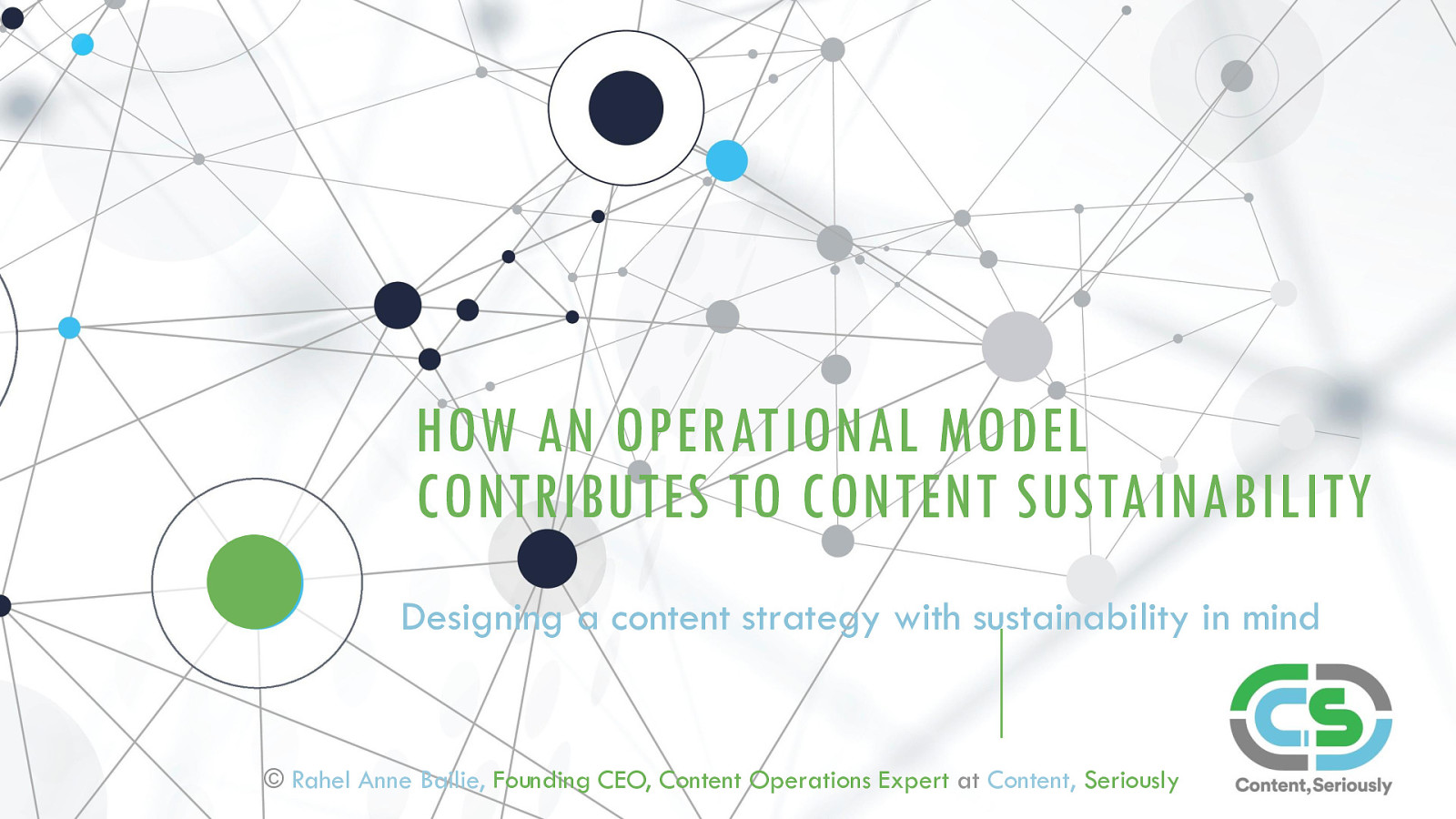
HOW AN OPERATIONAL MODEL CONTRIBUTES TO CONTENT SUSTAINABILITY
Designing a content strategy with sustainability in mind © Rahel Anne Bailie, Founding CEO, Content Operations Expert at Content, Seriously
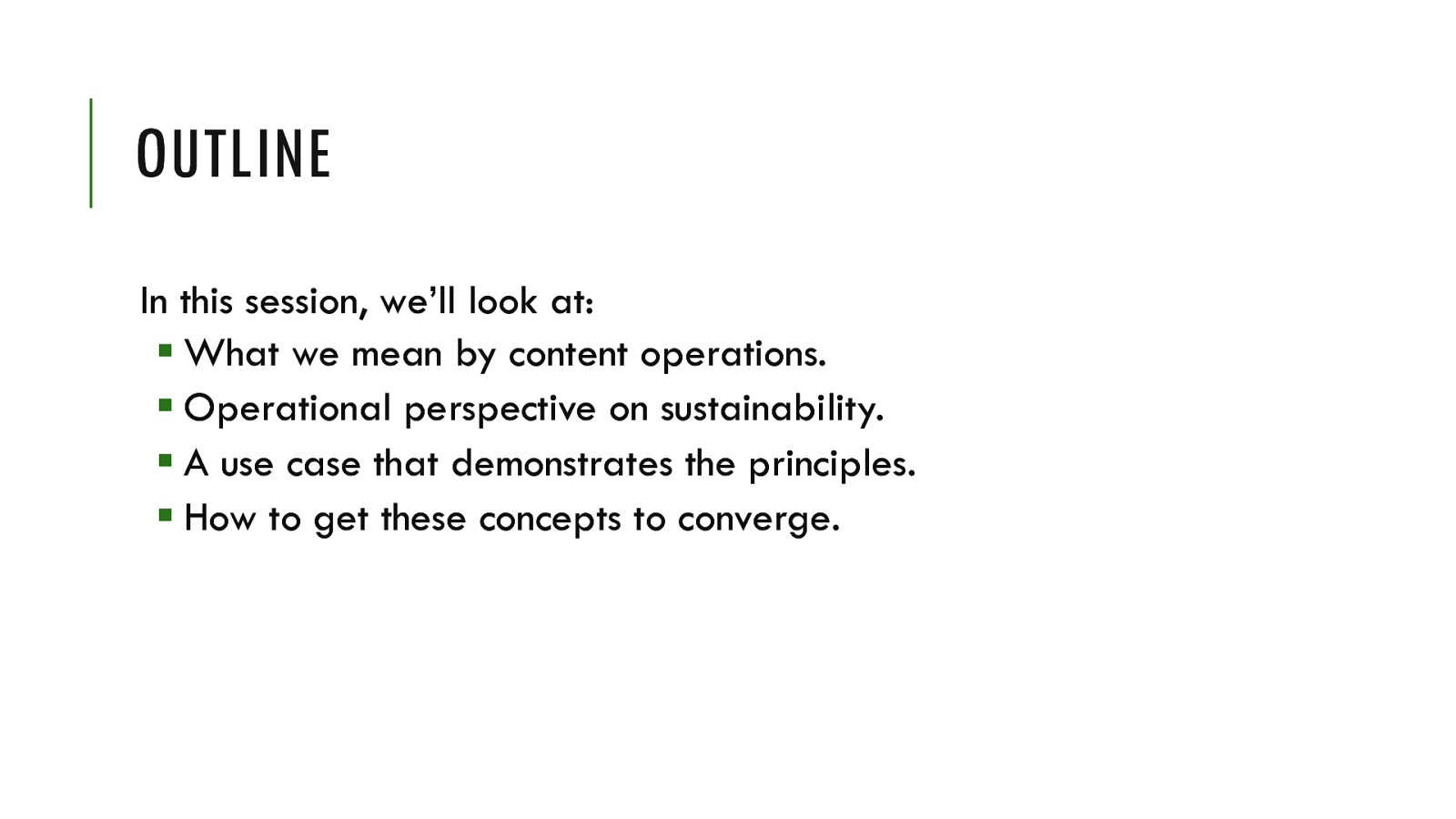
OUTLINE
In this session, we’ll look at: ▪ What we mean by content operations. ▪ Operational perspective on sustainability. ▪ A use case that demonstrates the principles. ▪ How to get these concepts to converge.
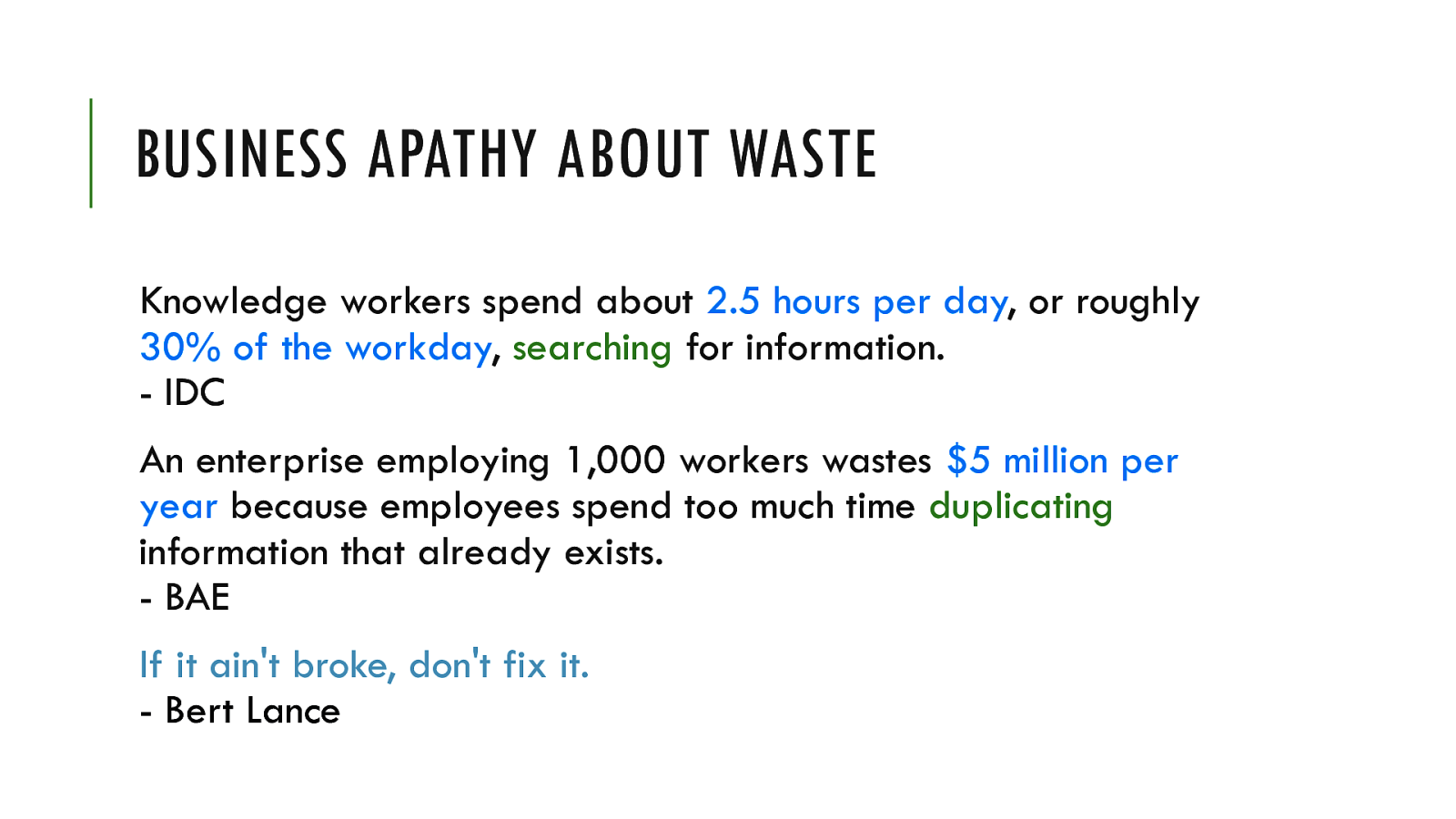
BUSINESS APATHY ABOUT WASTE
Knowledge workers spend about 2.5 hours per day, or roughly 30% of the workday, searching for information. - IDC An enterprise employing 1,000 workers wastes $5 million per year because employees spend too much time duplicating information that already exists. - BAE If it ain’t broke, don’t fix it. - Bert Lance
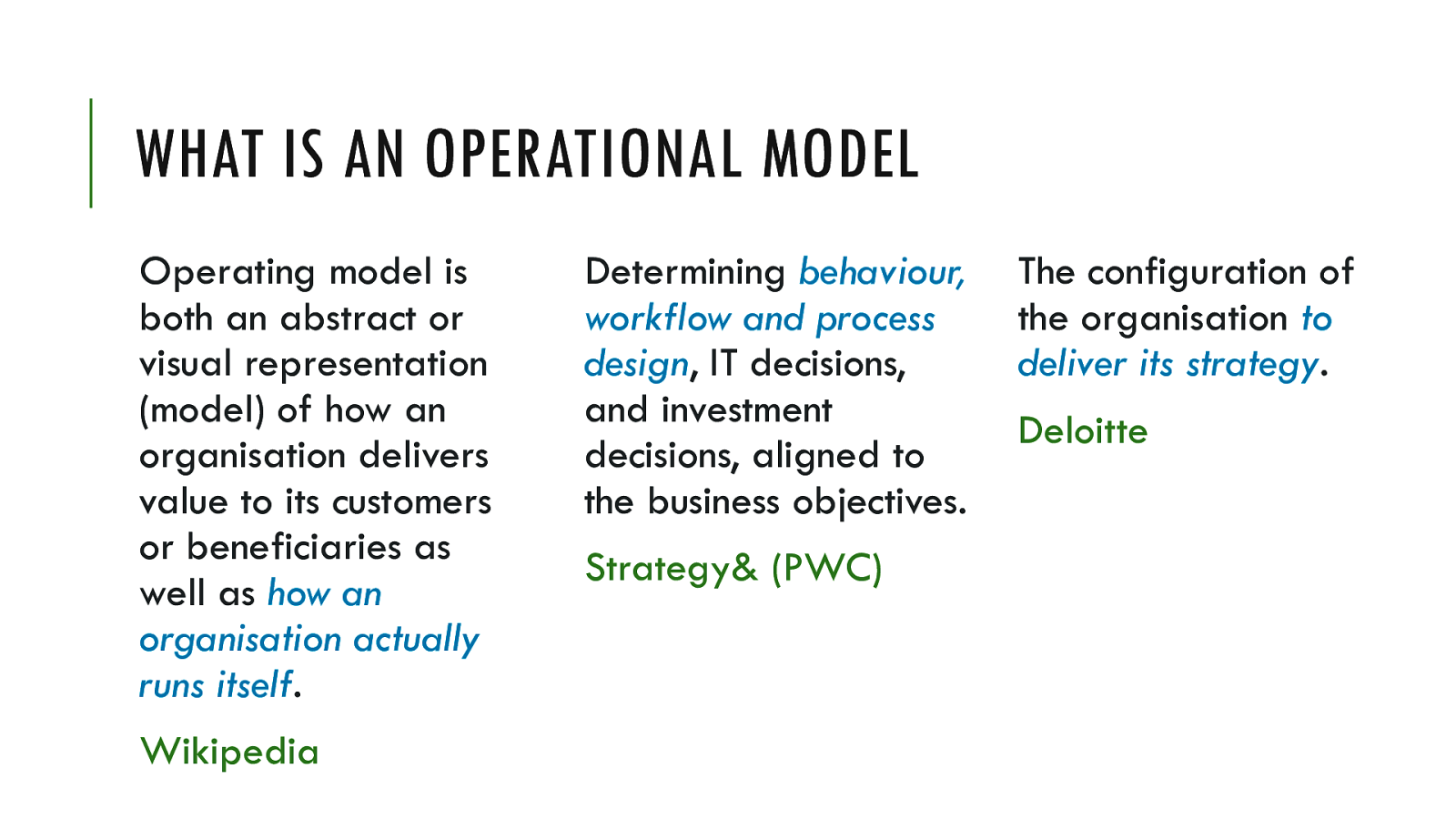
WHAT IS AN OPERATIONAL MODEL
Operating model is both an abstract or visual representation (model) of how an organisation delivers value to its customers or beneficiaries as well as how an organisation actually runs itself. Wikipedia Determining behaviour, workflow and process design, IT decisions, and investment decisions, aligned to the business objectives. Strategy& (PWC) The configuration of the organisation to deliver its strategy. Deloitte
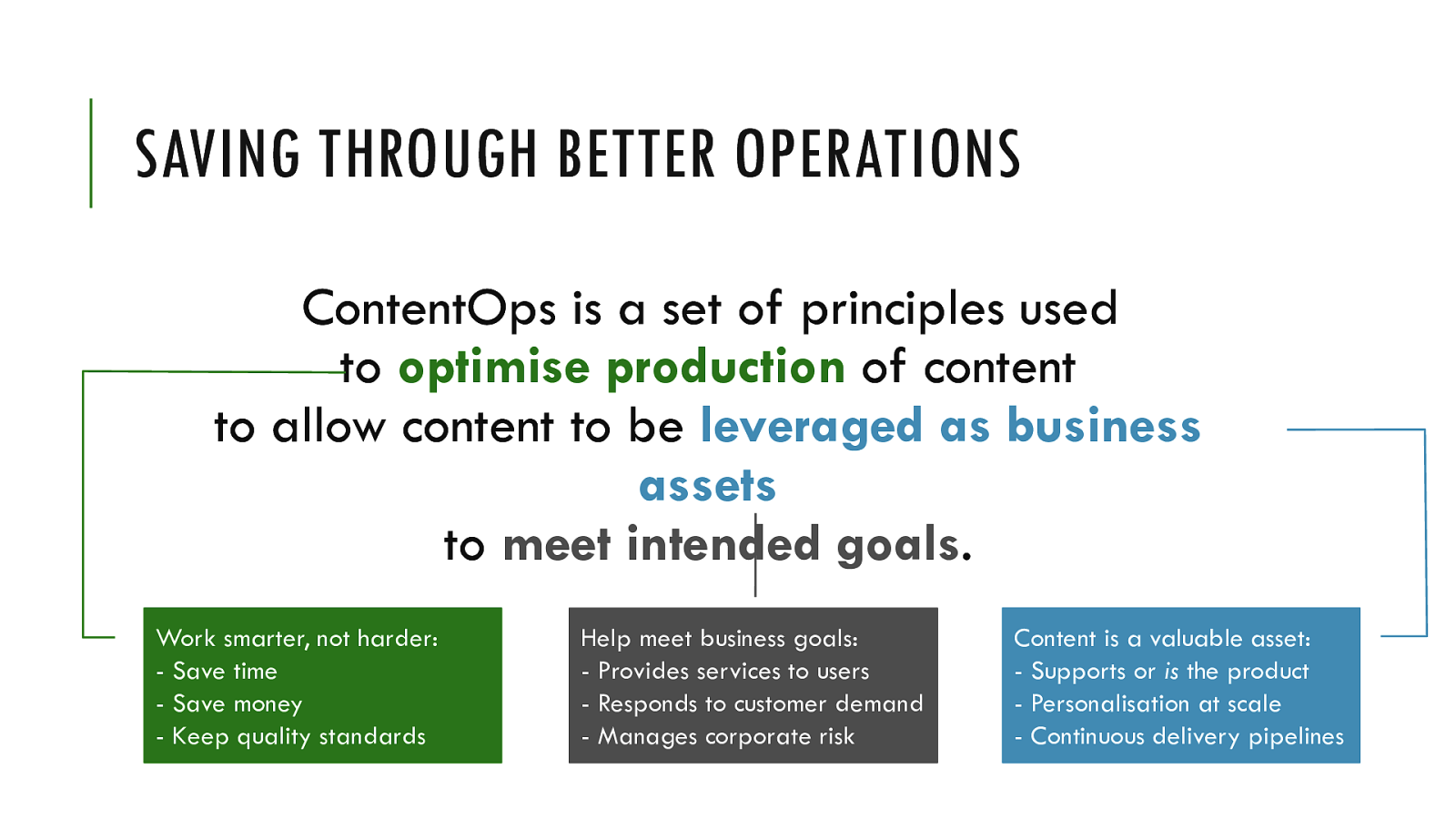
SAVING THROUGH BETTER OPERATIONS
ContentOps is a set of principles used to optimise production of content to allow content to be leveraged as business assets to meet intended goals. Optimise production = Work smarter, not harder: - Save time - Save money - Keep quality standards Leverage as business assets = Content is a valuable asset: - Supports or is the product - Personalisation at scale - Continuous delivery pipelines Meet intended goals = Help meet business goals: - Provides services to users - Responds to customer demand - Manages corporate risk
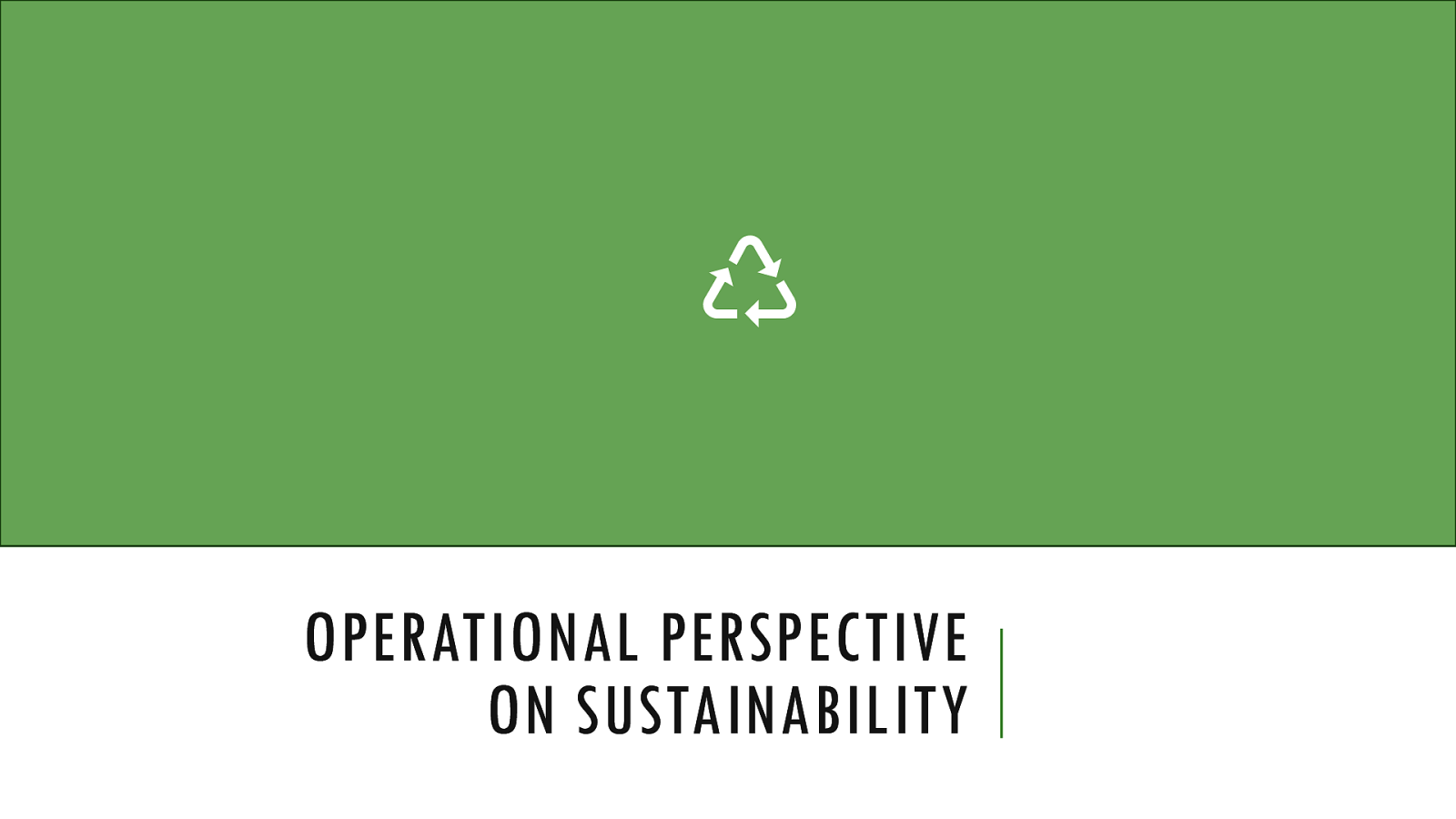
OPERATIONAL PERSPECTIVE ON SUSTAINABILITY
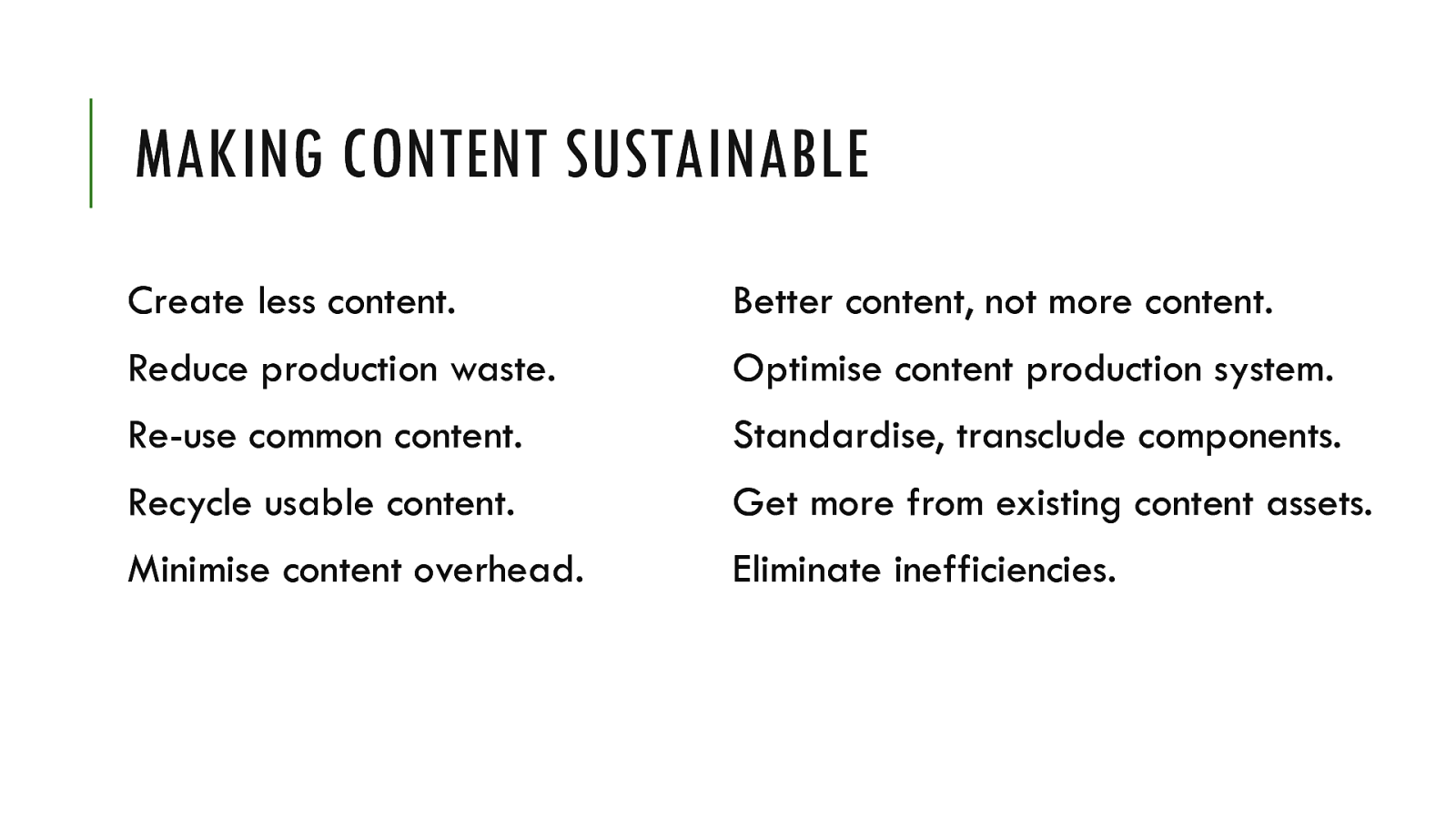
MAKING CONTENT SUSTAINABLE
Create less content. Better content, not more content. Reduce production waste. Optimise content production system. Re-use common content. Standardise, transclude components. Recycle usable content. Get more from existing content assets. Minimise content overhead. Eliminate inefficiencies.
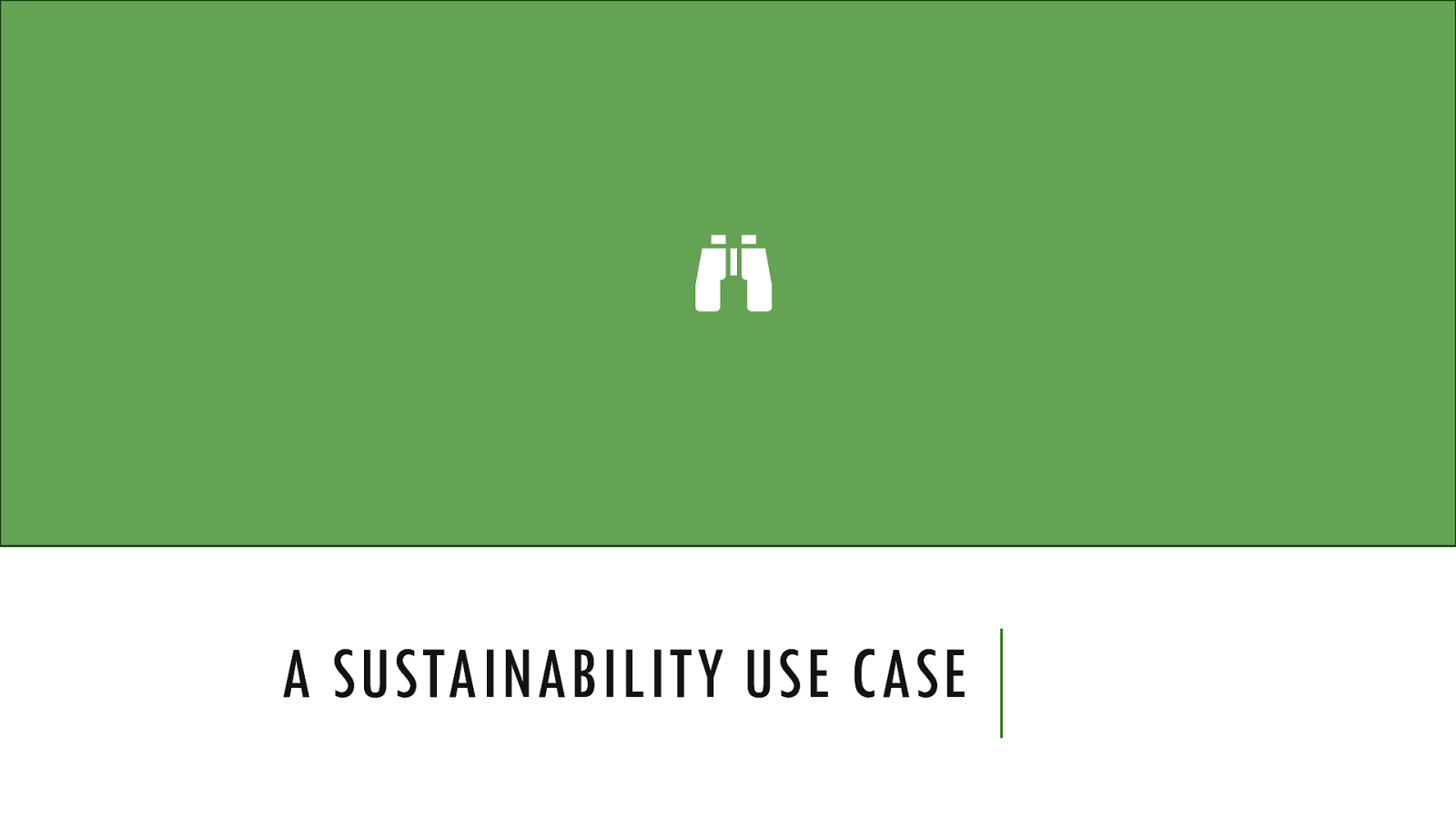
A SUSTAINABILITY USE CASE
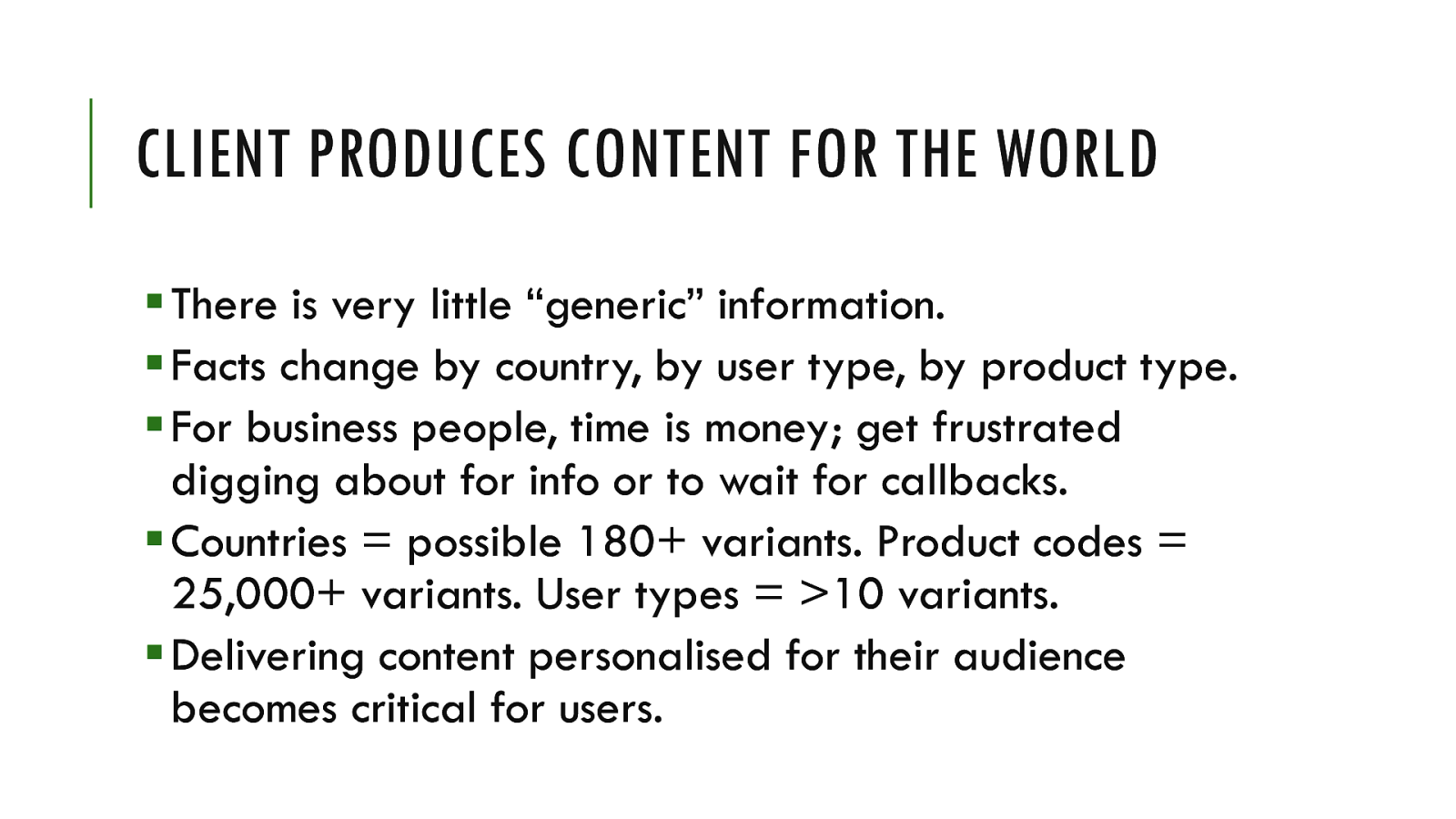
CLIENT PRODUCES CONTENT FOR THE WORLD
▪ There is very little “generic” information. ▪ Facts change by country, by user type, by product type. ▪ For business people, time is money; get frustrated digging about for info or to wait for callbacks. ▪ Countries = possible 180+ variants. Product codes = 25,000+ variants. User types = >10 variants. ▪ Delivering content personalised for their audience becomes critical for users.
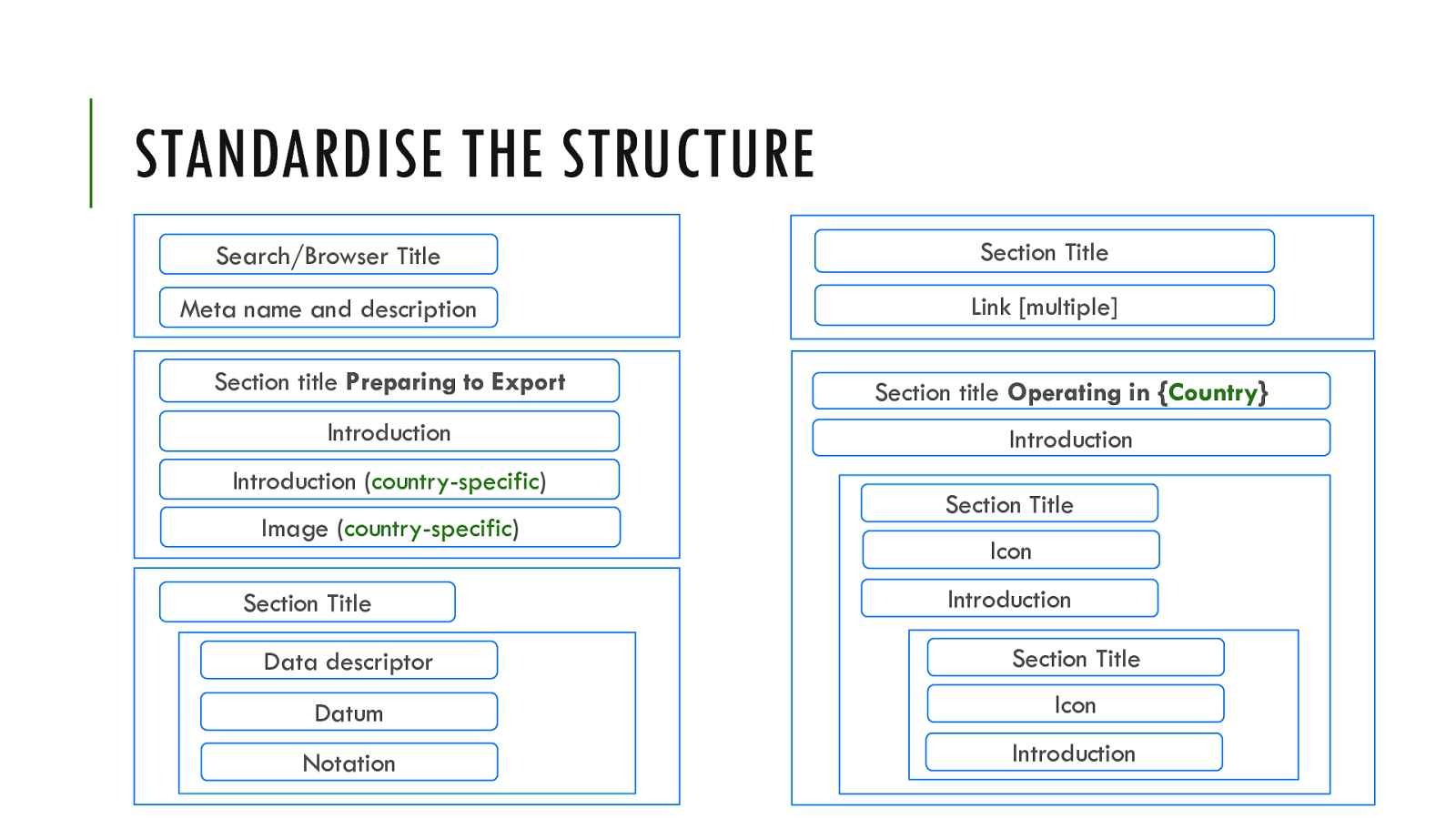
STANDARDISE THE STRUCTURE
Search/Browser Title Section Title Meta name and description Link [multiple] Section title Preparing to Export Section title Operating in {Country} Introduction Introduction Introduction (country-specific) Image (country-specific) Section Title Section Title Icon Introduction Data descriptor Section Title Datum Icon Notation Introduction
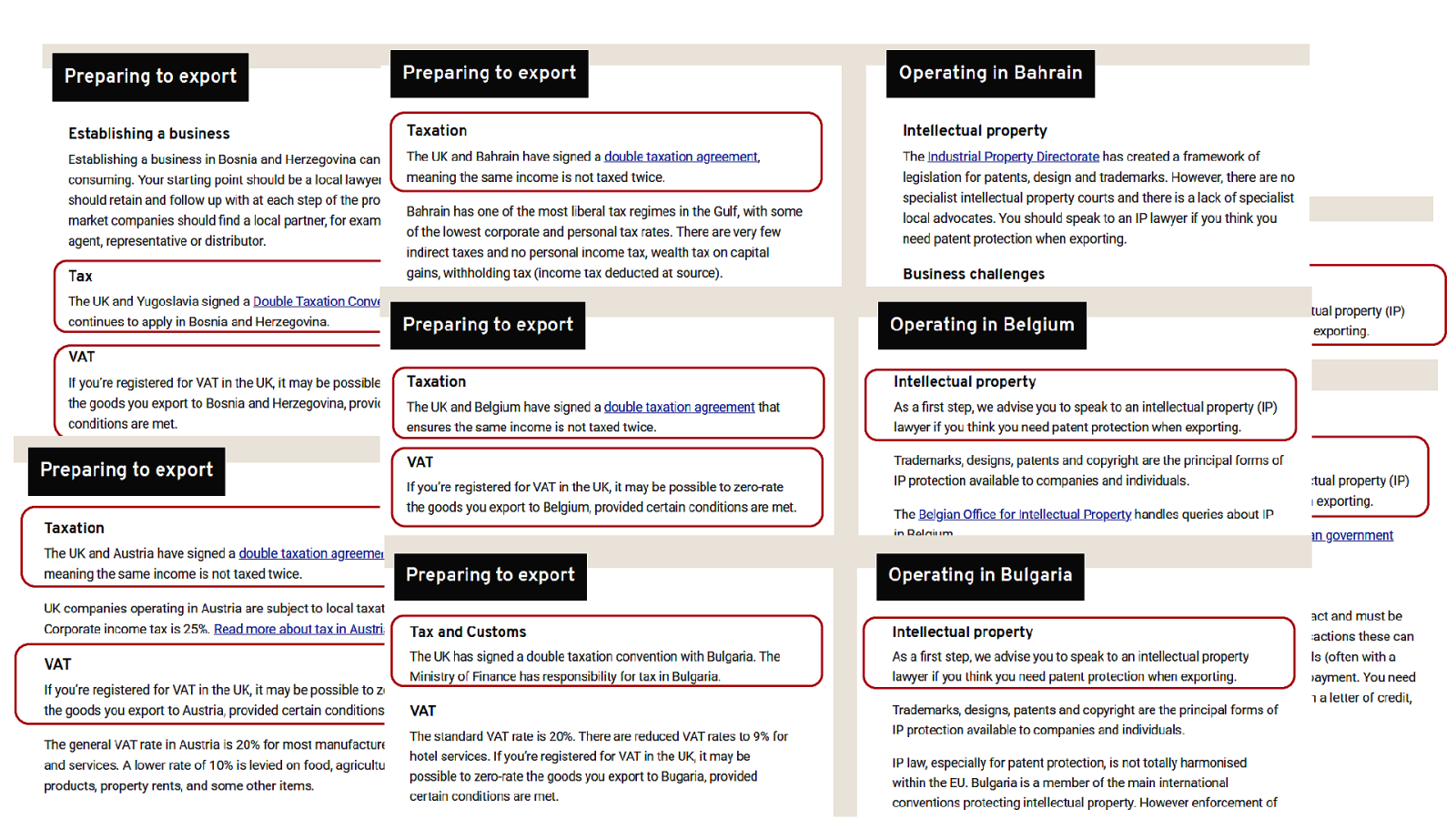
STANDARDISE THE CONTENT
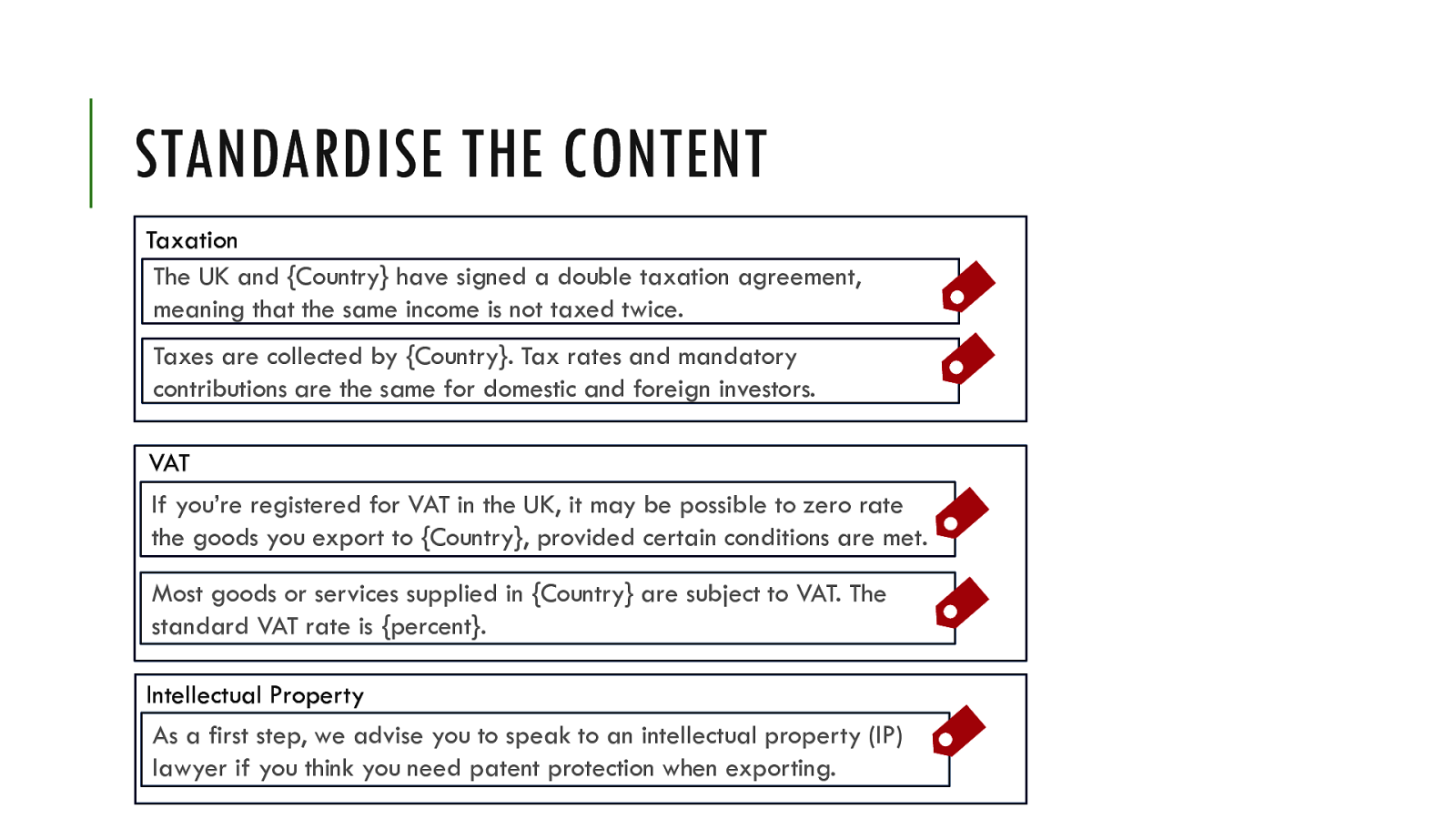
STANDARDISE THE CONTENT
Taxation The UK and {Country} have signed a double taxation agreement, meaning that the same income is not taxed twice. Taxes are collected by {Country}. Tax rates and mandatory contributions are the same for domestic and foreign investors. VAT If you’re registered for VAT in the UK, it may be possible to zero rate the goods you export to {Country}, provided certain conditions are met. Most goods or services supplied in {Country} are subject to VAT. The standard VAT rate is {percent}. Intellectual Property As a first step, we advise you to speak to an intellectual property (IP) lawyer if you think you need patent protection when exporting.
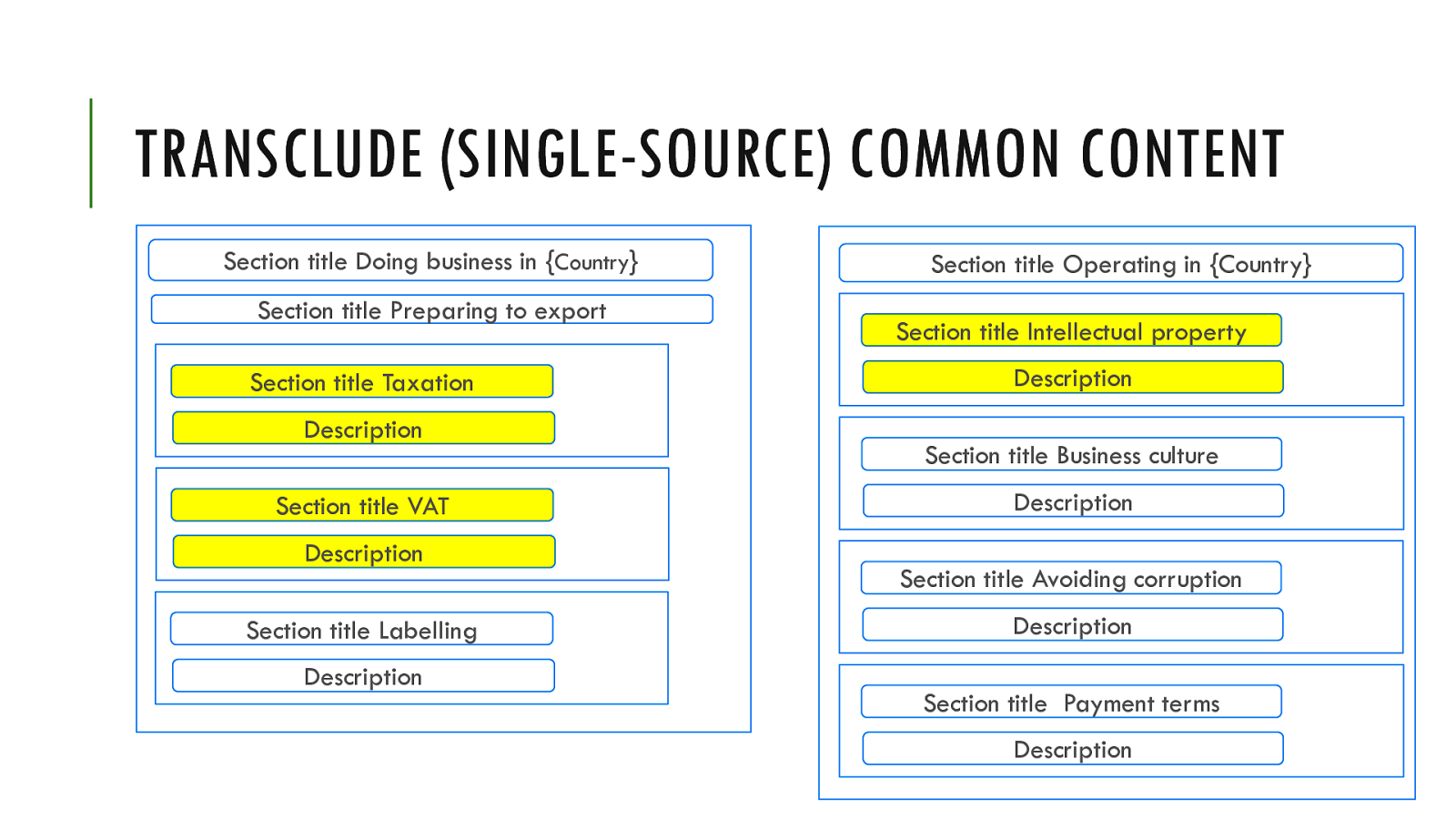
TRANSCLUDE (SINGLE-SOURCE) COMMON CONTENT
Section title Doing business in {Country} Section title Preparing to export Section title Taxation Description Section title VAT Description Section title Labelling Description Section title Operating in {Country} Section title Intellectual property Description Section title Business culture Description Section title Avoiding corruption Description Section title Payment terms Description
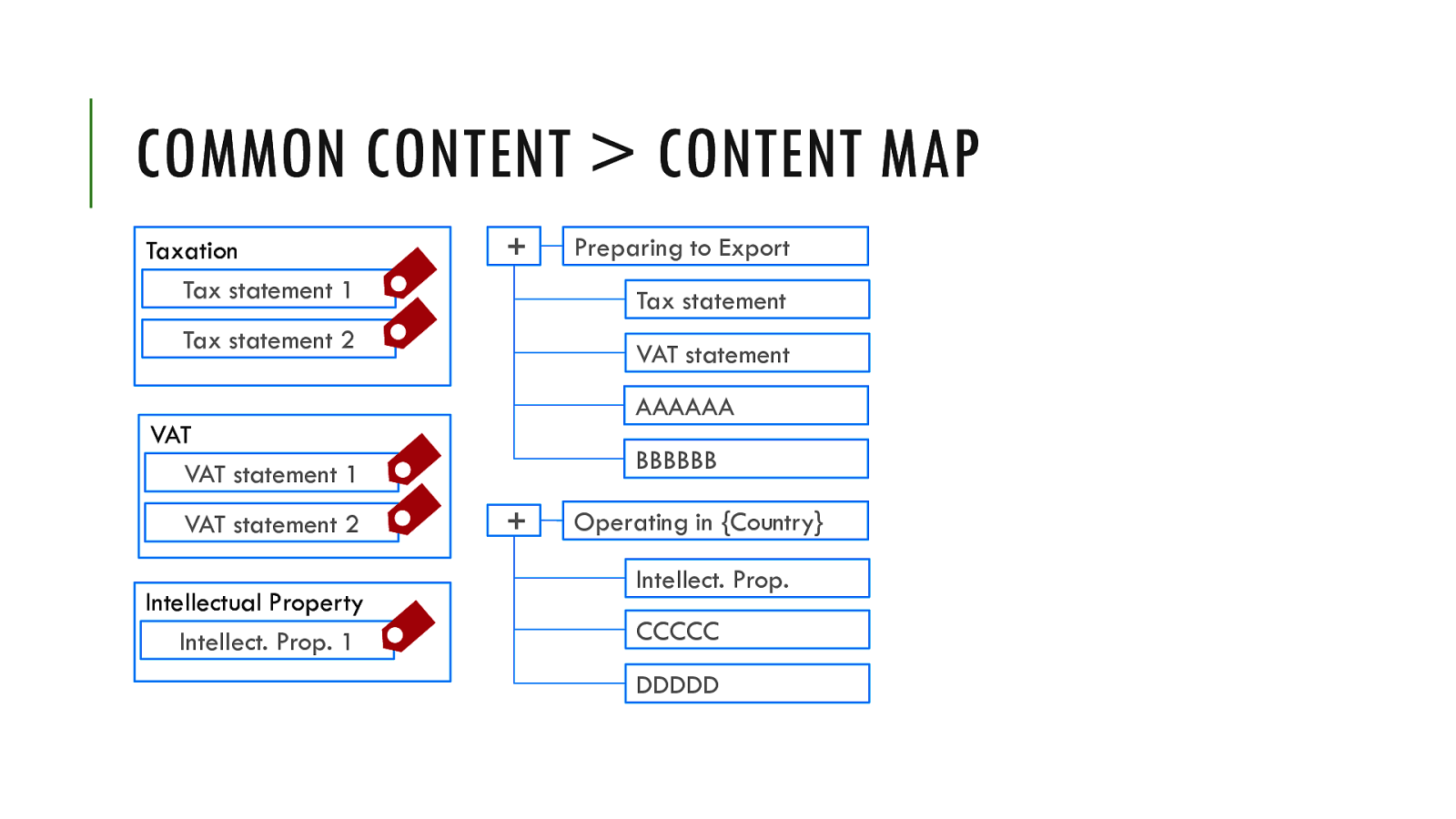
COMMON CONTENT > CONTENT MAP
Taxation Tax statement 1 + Tax statement Tax statement 2 VAT statement AAAAAA VAT VAT statement 1 VAT statement 2 Intellectual Property Intellect. Prop. 1 Preparing to Export BBBBBB + Operating in {Country} Intellect. Prop. CCCCC DDDDD

AUTOMATE THE POPULATION OF DATA
▪ Data sets already exist ▪ Can auto-populate at time of publication ▪ Keeps published information fresh
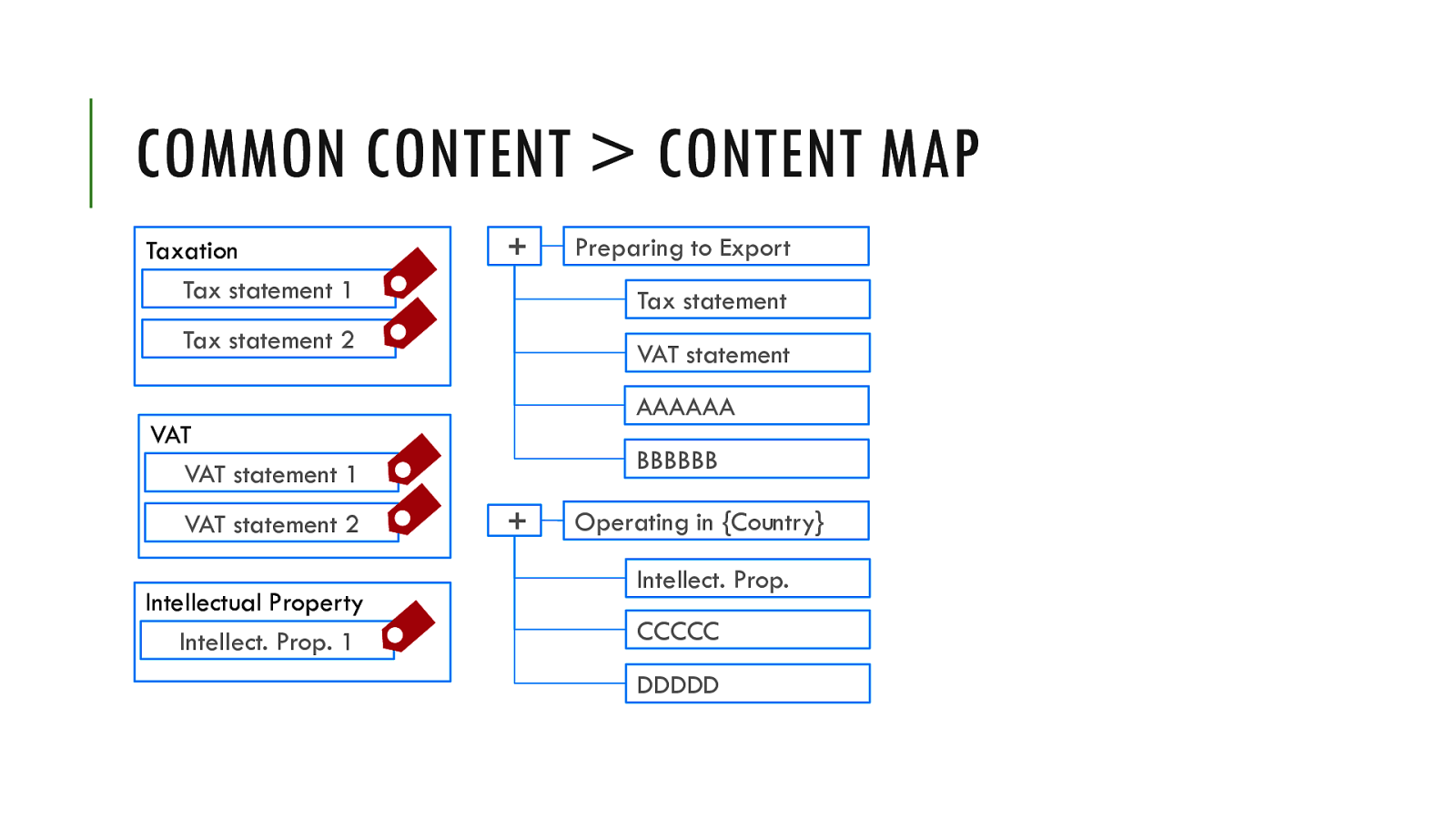
COMMON CONTENT > CONTENT MAP
Taxation Tax statement 1 + Tax statement Tax statement 2 VAT statement AAAAAA VAT VAT statement 1 VAT statement 2 Intellectual Property Intellect. Prop. 1 Preparing to Export BBBBBB + Operating in {Country} Intellect. Prop. CCCCC DDDDD
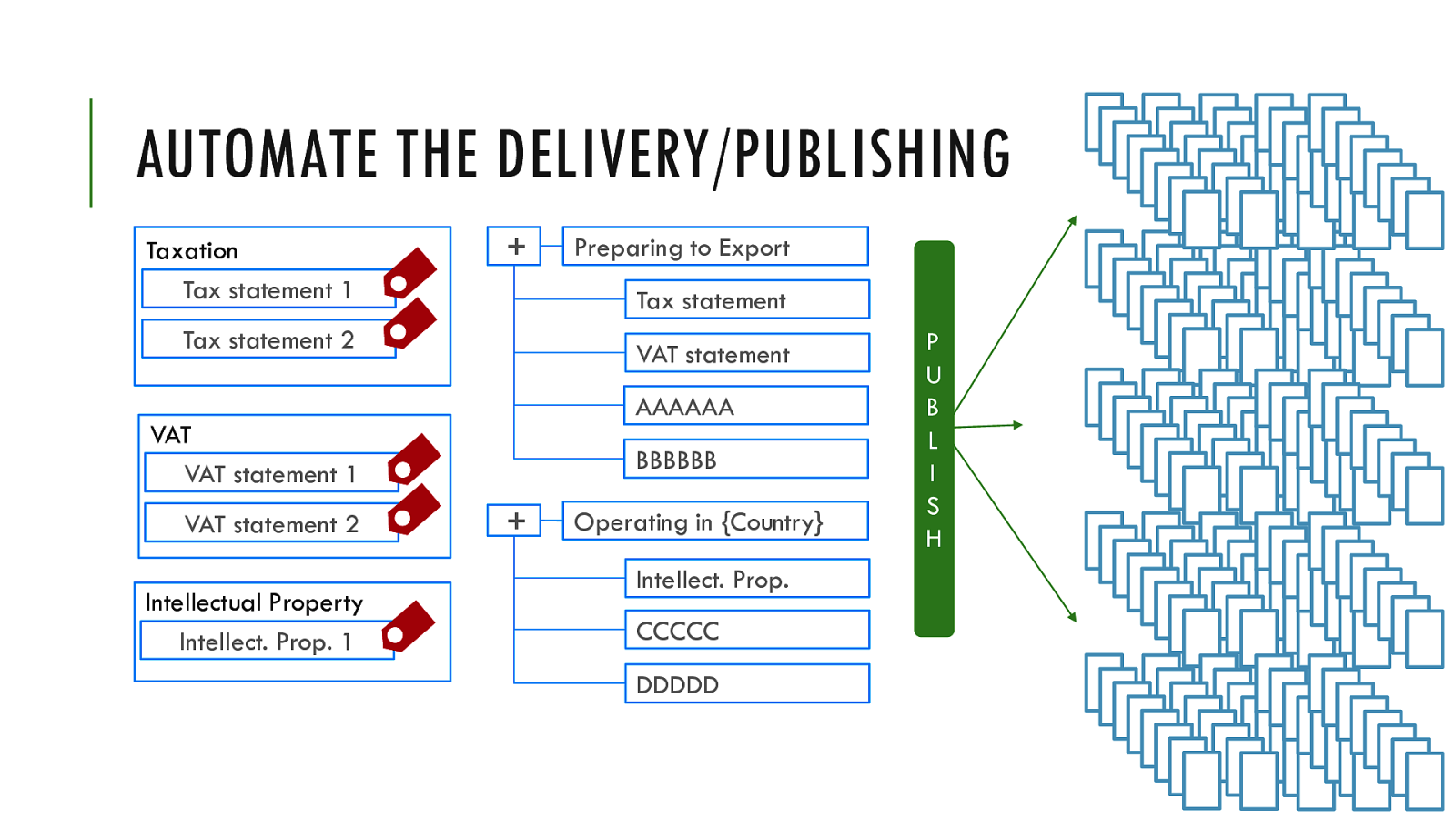
AUTOMATE THE DELIVERY/PUBLISHING
Taxation Tax statement 1 + Tax statement Tax statement 2 VAT statement AAAAAA VAT VAT statement 1 VAT statement 2 Intellectual Property Intellect. Prop. 1 Preparing to Export BBBBBB + Operating in {Country} Intellect. Prop. CCCCC DDDDD P U B L I S H
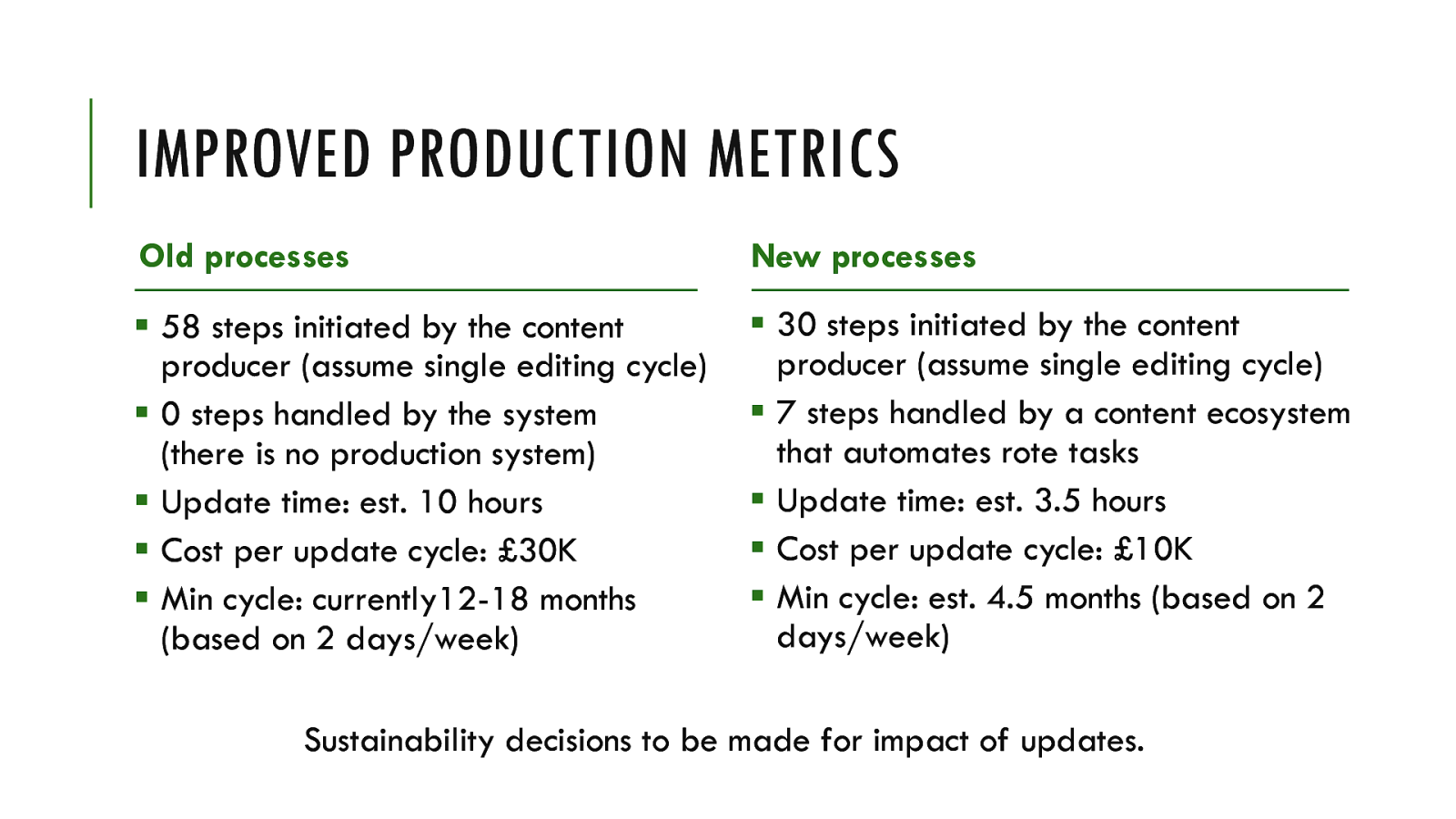
IMPROVED PRODUCTION METRICS
Old processes 58 steps initiated by the content producer (assume single editing cycle) 0 steps handled by the system (there is no production system) Update time: est. 10 hours Cost per update cycle: £30K Min cycle: currently12-18 months (based on 2 days/week)
New processes 30 steps initiated by the content producer (assume single editing cycle) 7 steps handled by a content ecosystem that automates rote tasks Update time: est. 3.5 hours Cost per update cycle: £10K Min cycle: est. 4.5 months (based on 2 days/week)
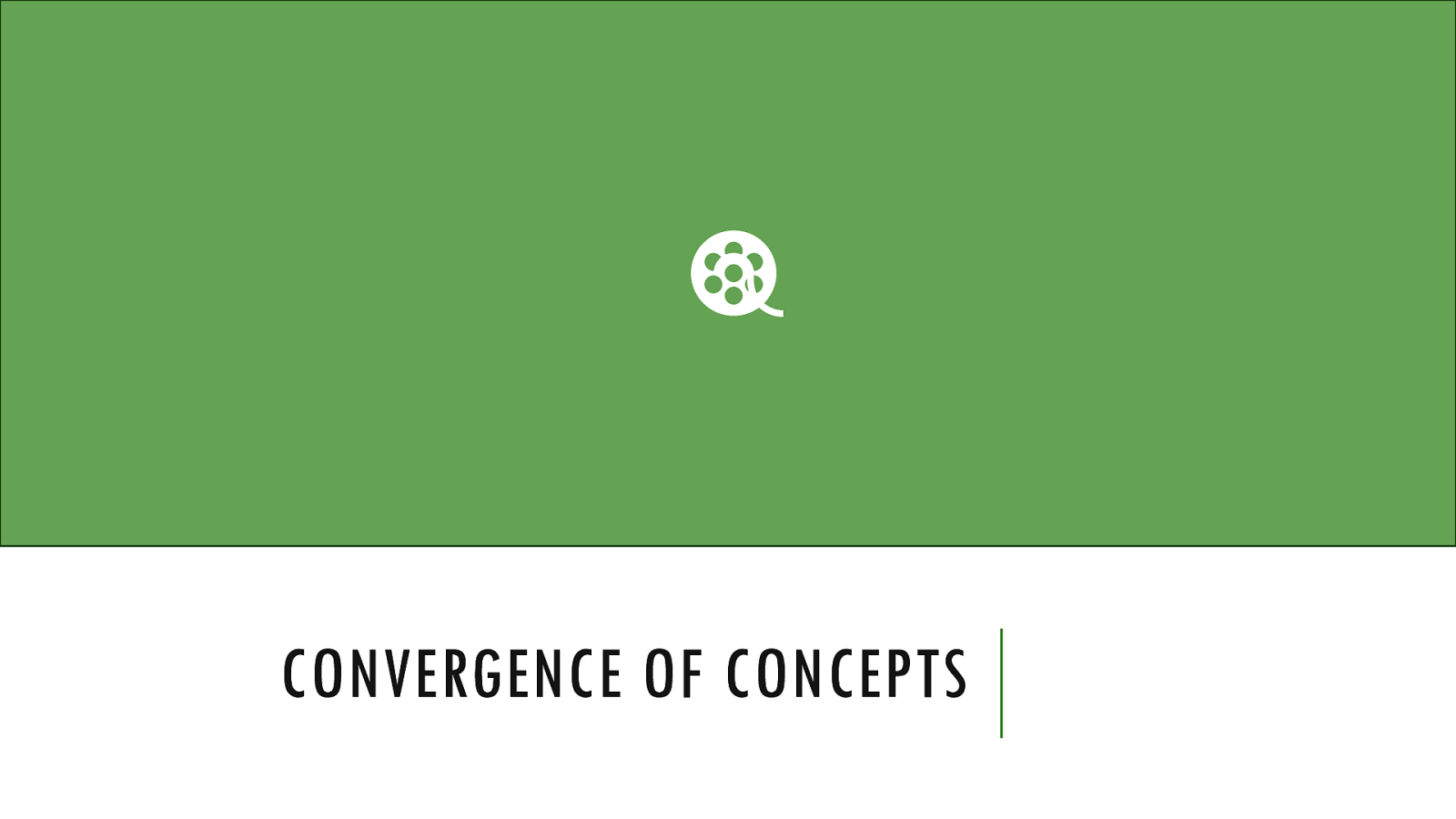
CONVERGENCE OF CONCEPTS
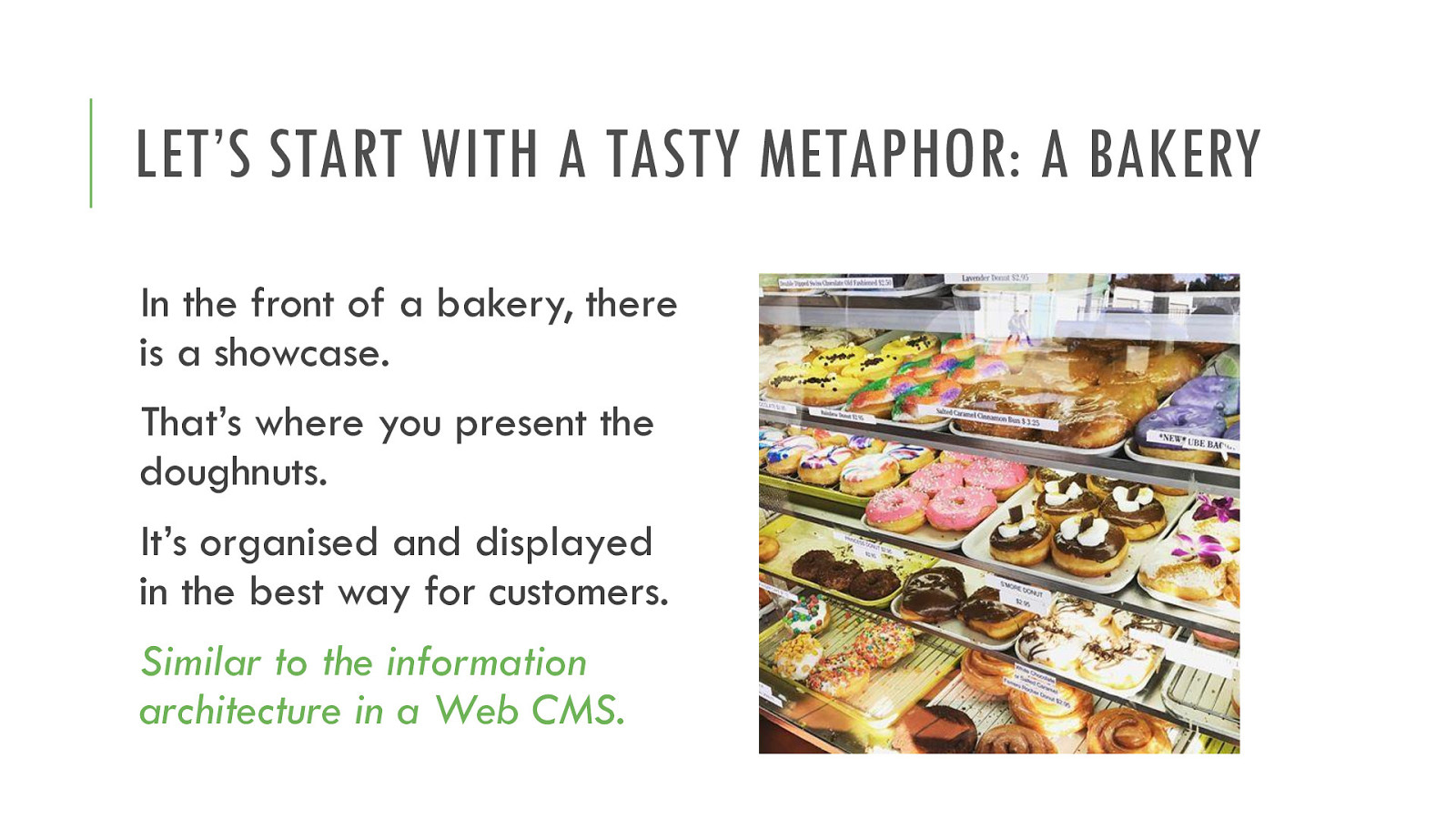
LET’S START WITH A TASTY METAPHOR: A BAKERY
In the front of a bakery, there is a showcase. That’s where you present the doughnuts. It’s organised and displayed in the best way for customers. Similar to the information architecture in a Web CMS.
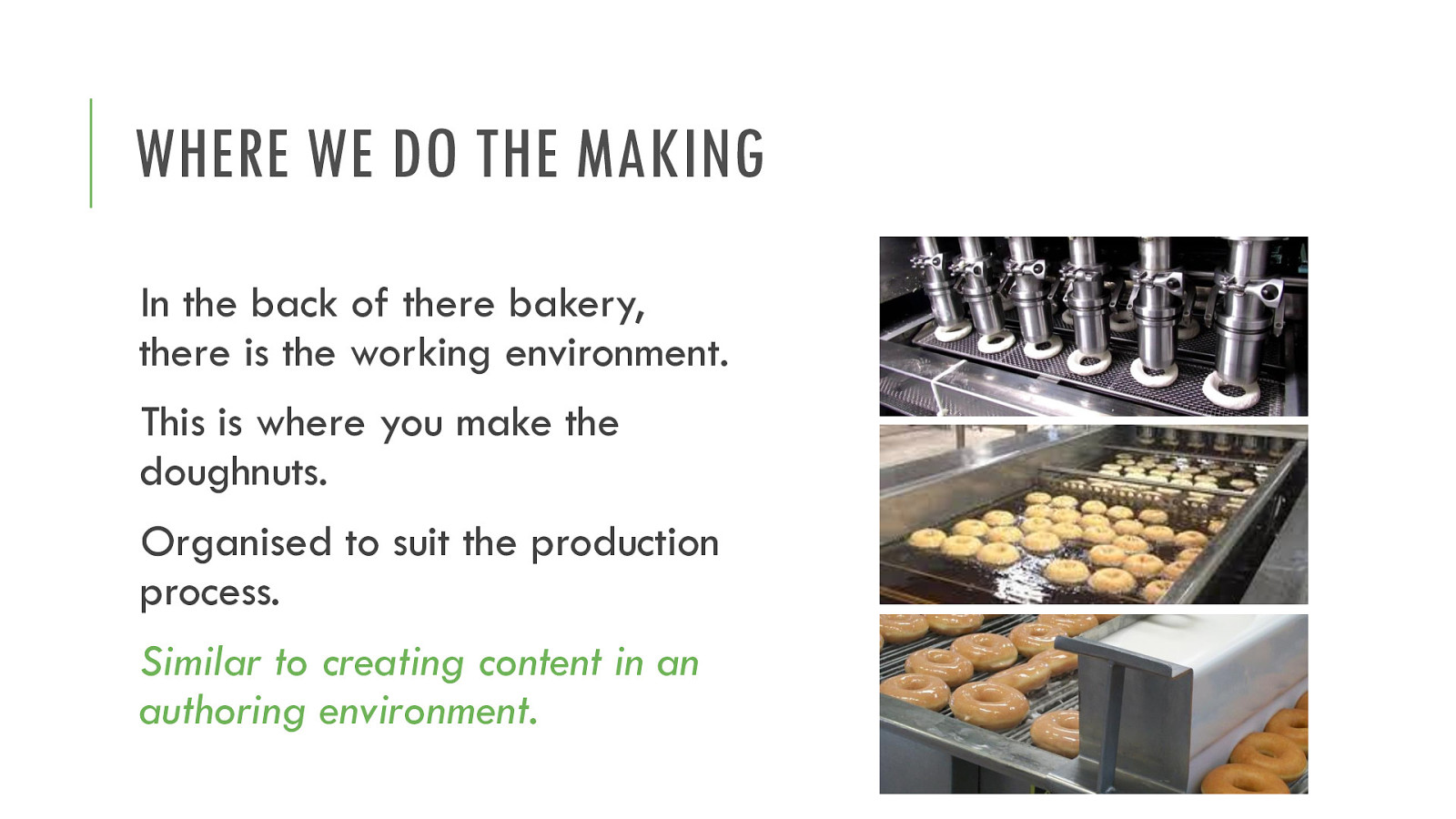
WHERE WE DO THE MAKING
In the back of there bakery, there is the working environment. This is where you make the doughnuts. Organised to suit the production process. Similar to creating content in an authoring environment.
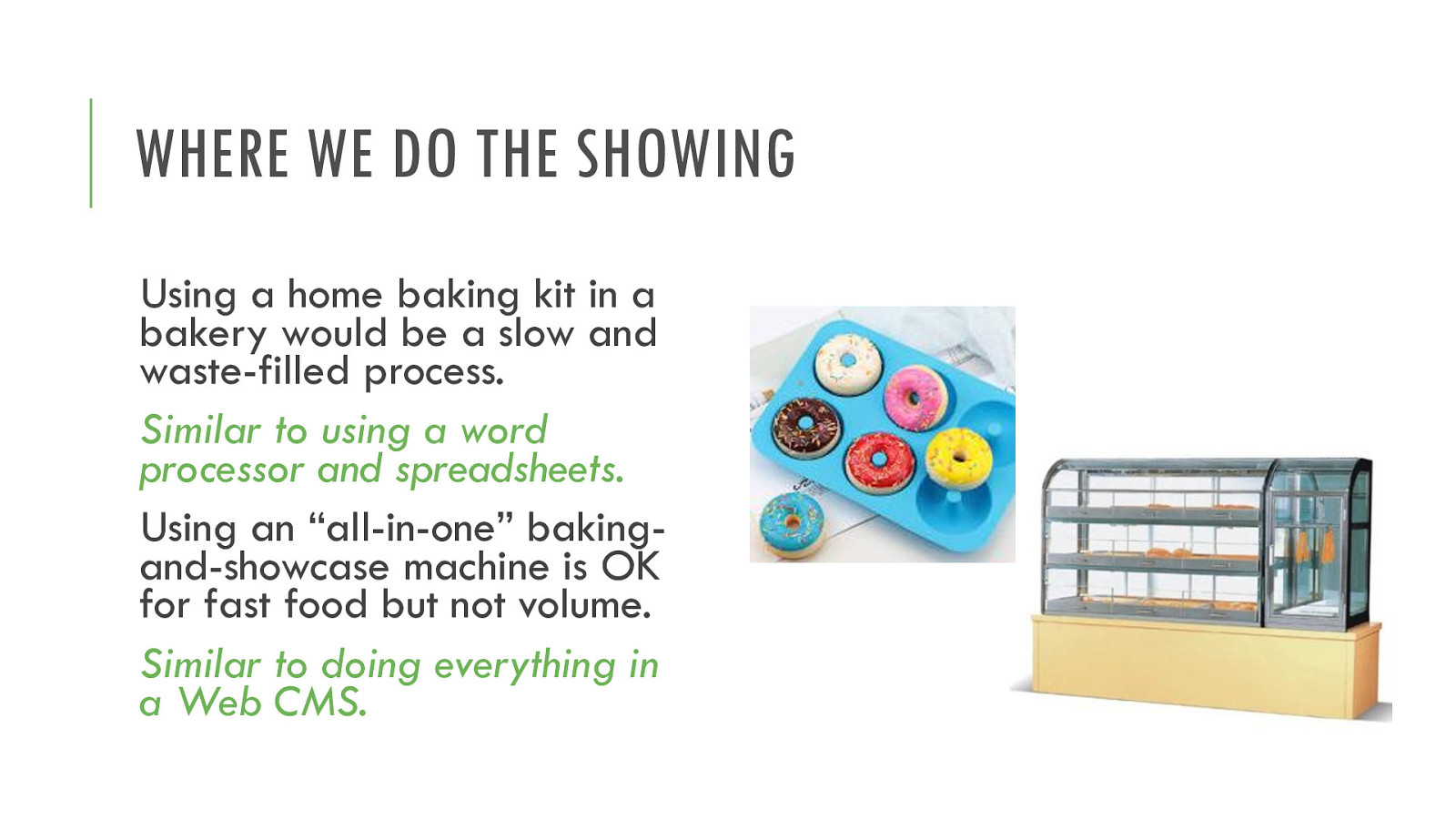
WHERE WE DO THE SHOWING
Using a home baking kit in a bakery would be a slow and waste-filled process. Similar to using a word processor and spreadsheets. Using an “all-in-one” baking-and-showcase machine is OK for fast food but not volume. Similar to doing everything in a Web CMS.

Content is one of the oldest disciplines yet has the least mature operational controls.
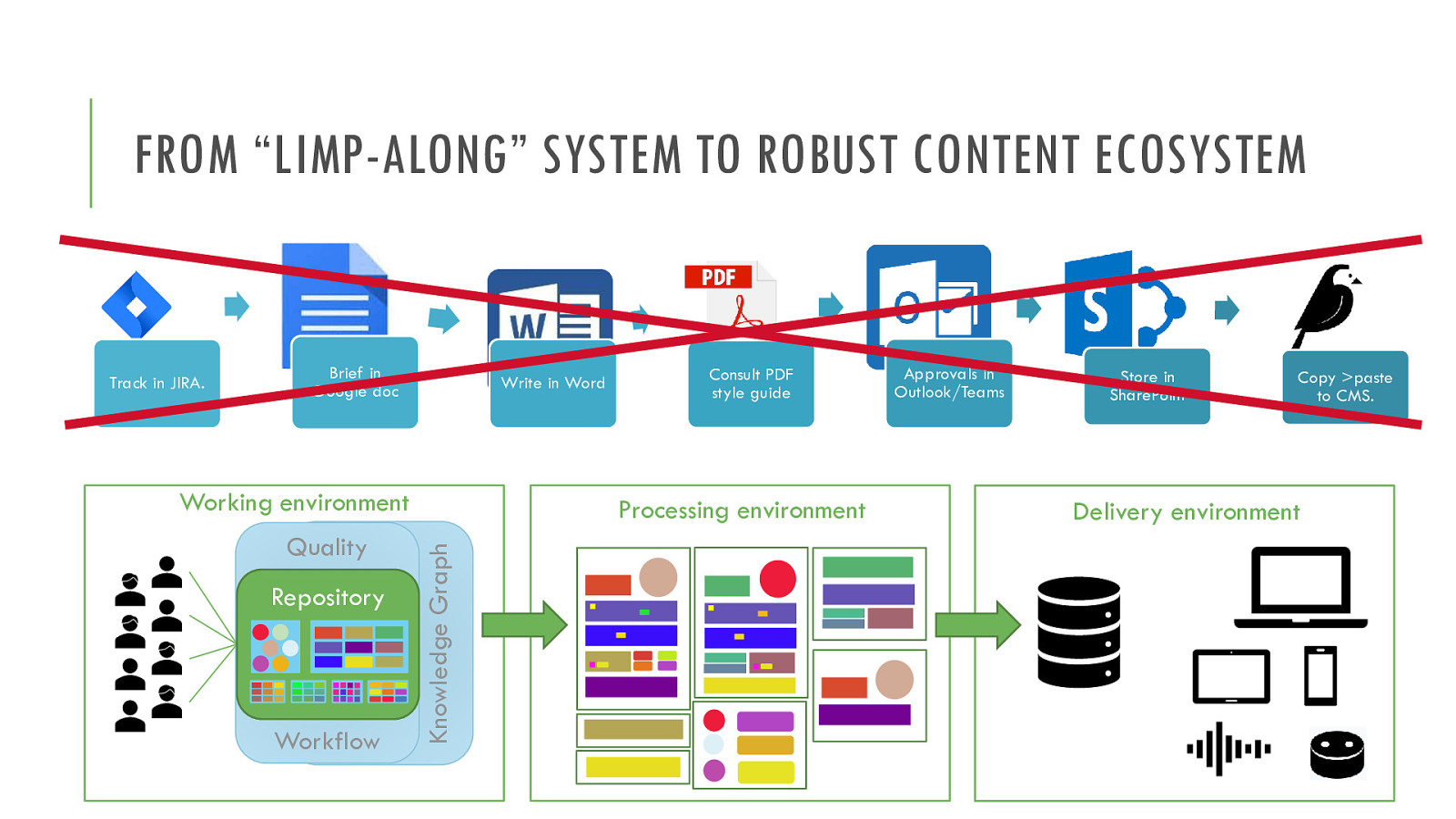
FROM “LIMP-ALONG” SYSTEM TO ROBUST CONTENT ECOSYSTEM
Limp-along system: Track in JIRA. Brief in Google doc Write in Word Consult PDF style guide Approvals in Outlook/Teams store in SharePoint Copy>paste to CMS
Robust content ecosystem: Working environment
- Repository
- Workflow
- Quality optimisation
- Knowledge graph Processing environment Delivery environment
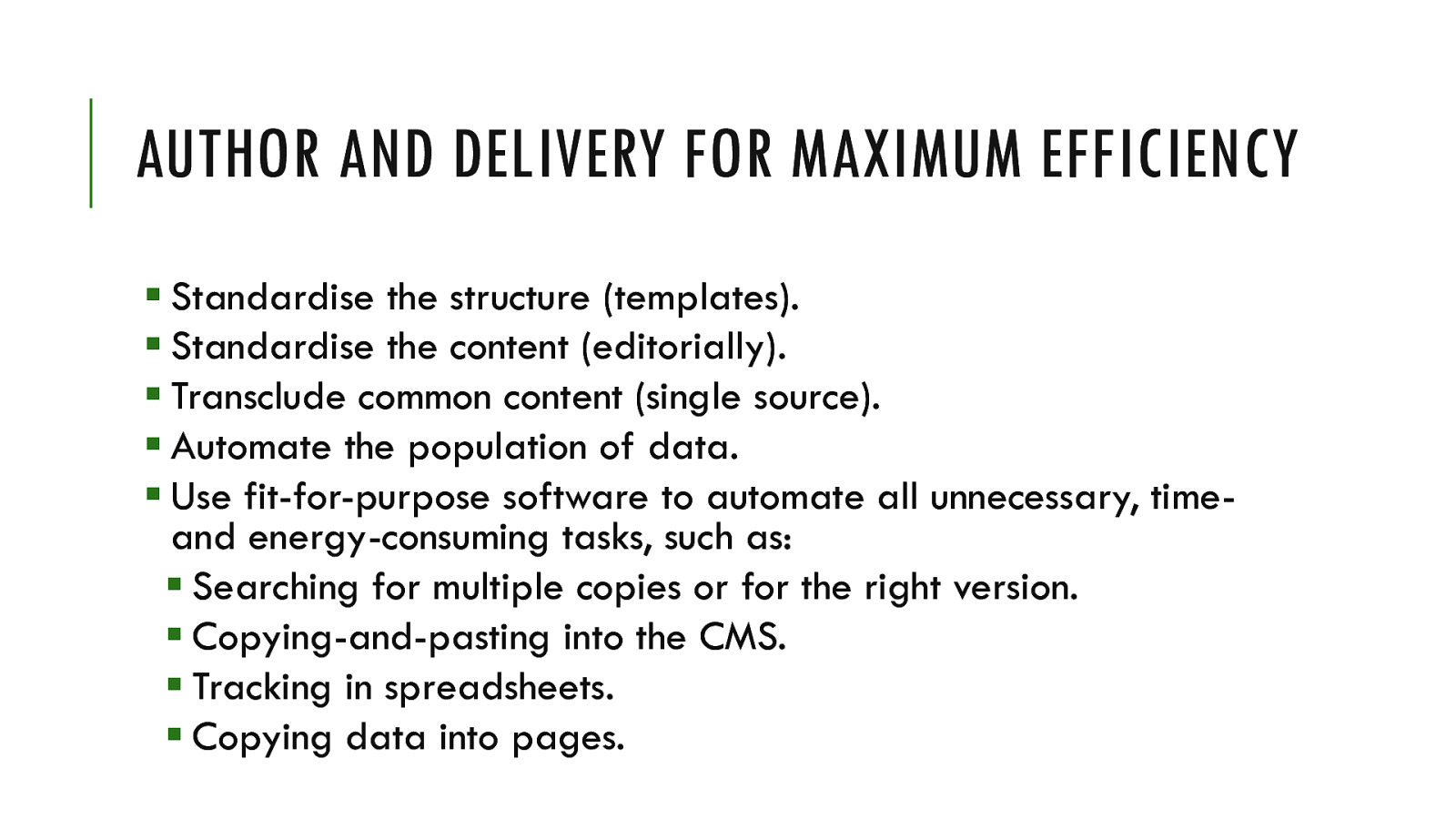
AUTHOR AND DELIVERY FOR MAXIMUM EFFICIENCY
Standardise the structure (templates). Standardise the content (editorially). Transclude common content (single source). Automate the population of data. Use fit-for-purpose software to automate all unnecessary, time- and energy-consuming tasks, such as: Searching for multiple copies or for the right version. Copying-and-pasting into the CMS. Tracking in spreadsheets. Copying data into pages.

WRAP-UP
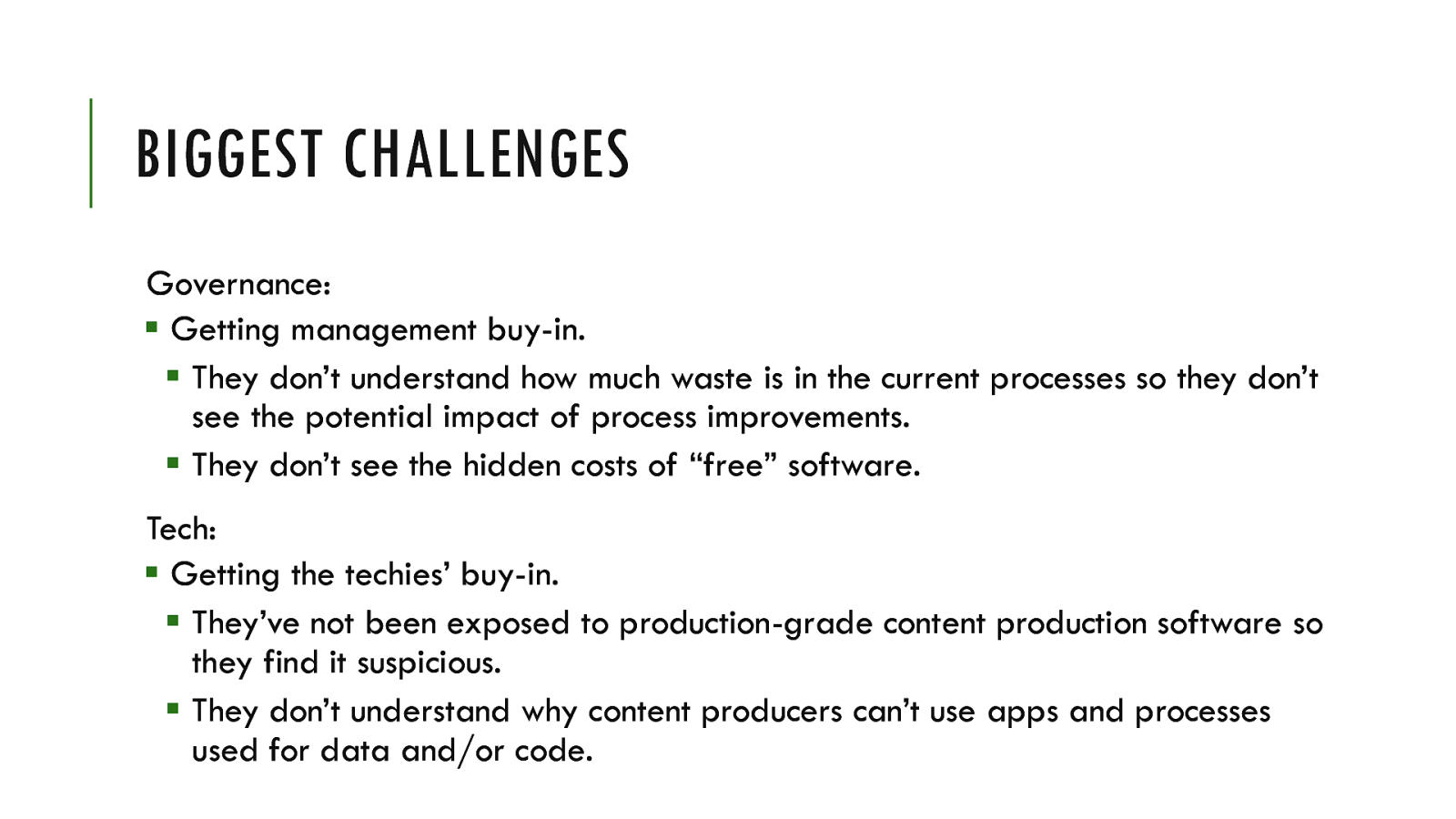
BIGGEST CHALLENGES
Governance: Getting management buy-in. They don’t understand how much waste is in the current processes so they don’t see the potential impact of process improvements. They don’t see the hidden costs of “free” software. Tech: Getting the techies’ buy-in. They’ve not been exposed to production-grade content production software so they find it suspicious. They don’t understand why content producers can’t use apps and processes used for data and/or code.
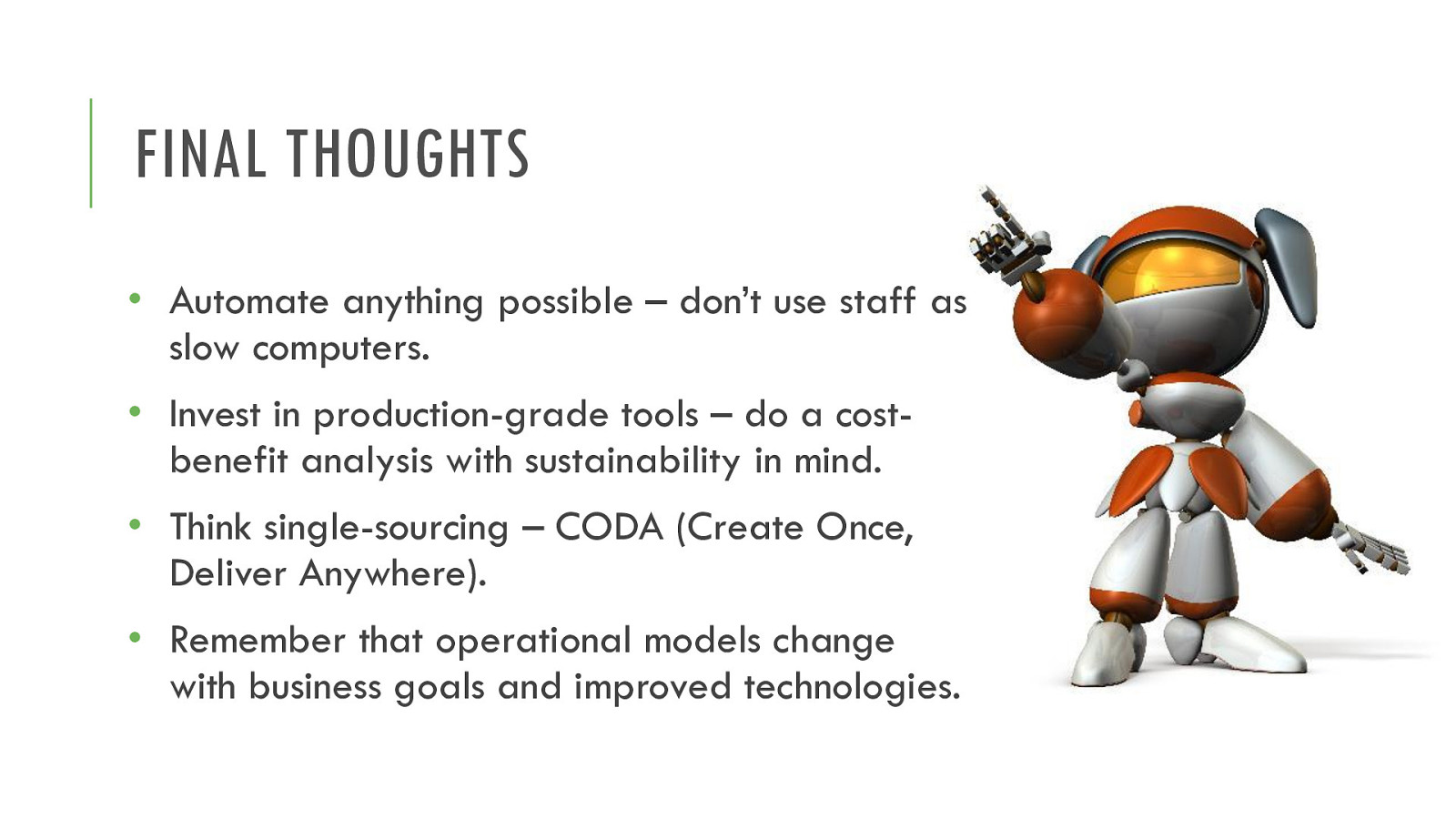
FINAL THOUGHTS
• Automate anything possible – don’t use staff as slow computers. • Invest in production-grade tools – do a costbenefit analysis with sustainability in mind. • Think single-sourcing – CODA (Create Once, Deliver Anywhere). • Remember that operational models change with business goals and improved technologies.
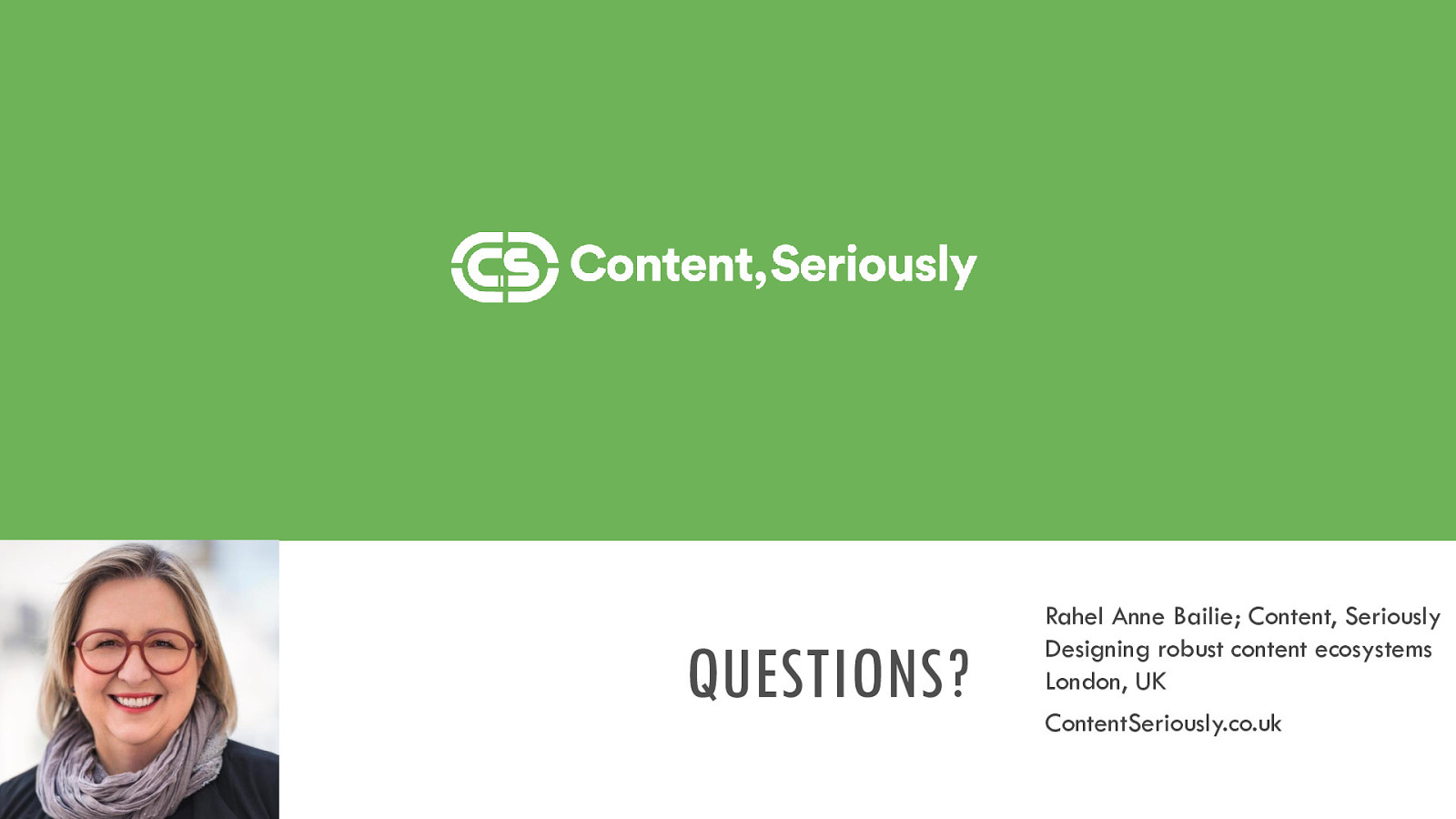
QUESTIONS?
Contact info: Rahel Anne Bailie; Content, Seriously Designing robust content ecosystems London, UK ContentSeriously.co.uk
Content operations isn’t only about eliminating waste and improving process efficiency. It’s also a contributor to sustainable content: leveraging content assets to realise their maximum potential.
